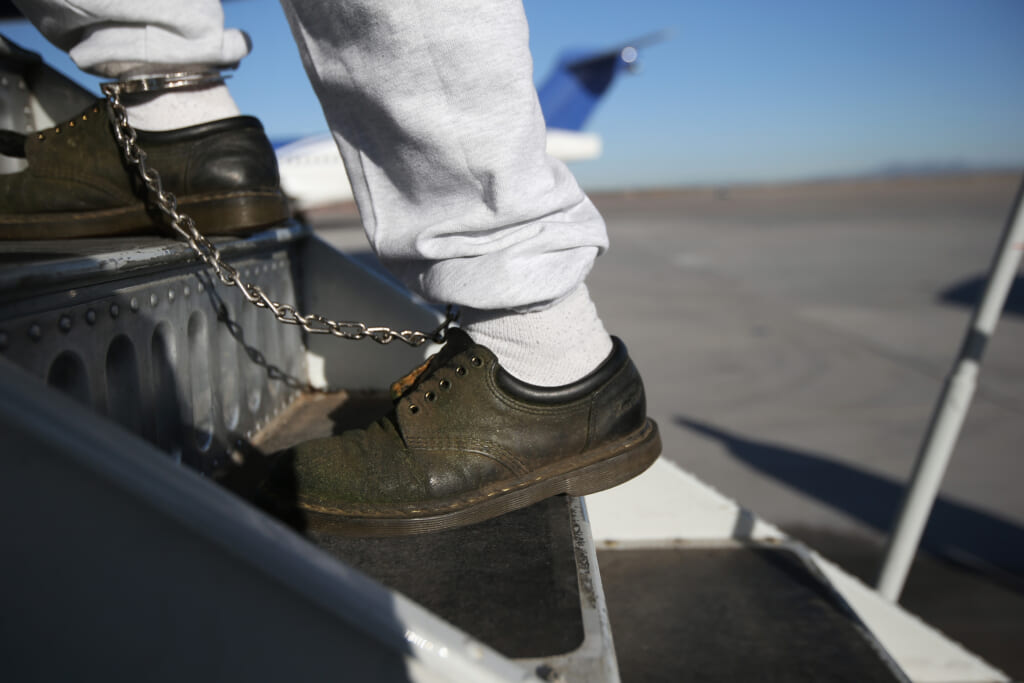Black migrants tortured by ICE officers using ‘human restraint,’ DHS complaint says
EXCLUSIVE: Weeks after U.S. Border Patrol’s ‘whip’ scandal, new complaint says WRAP device used by officers violates civil and human rights

On the heels of an ongoing investigation at the U.S. Department of Homeland Security into the mistreatment of Haitian migrants at the U.S.-Mexico border last month, Black immigrant advocates say the abuses of Black and African migrants extend beyond what the world saw in now-viral images of Border Patrol agents on horseback in Del Rio, Texas.
In a letter sent to DHS’s Office of Civil Rights and Civil Liberties, obtained by theGrio, Black immigration rights groups are calling out alleged abuses committed by DHS’s Immigration and Customs Enforcement (ICE). The law enforcement agency is accused of torturing four Cameroon migrants and one Ugandan before and during mass deportations late last year.
At the center of these alleged abuses is a “human restraint” device used by ICE agents called The WRAP. The complaint alleges that officials used the restraint inhumanely and improperly, violating civil rights laws and ICE’s own detention standards.
The migrant complainants detail harrowing accounts of being forced into The WRAP restraint without cause and, in some cases, being left in the device for hours at a time. Each of them, two of whom spoke with TheGrio, have submitted signed declarations in support of the complaint filed by Black Alliance for Just Immigration, UndocuBlack, Haitian Bridge Alliance and the Texas A&M School of Law Immigrant Rights Clinic.
The abuses are alleged to have happened on or before two mass deportation flights that carried dozens to Cameroon, a war-torn country in central Africa, on Oct. 13, 2020, and Nov. 11, 2020. In each incident, ICE officials placed the migrants in The WRAP, which, according to the complaint, is supposed to restrain the legs “with the arms cuffed at the back, leaving the restrained in a seated, upright, 90-degree position so that the lungs and airways are free from compression.”
The WRAP, manufactured by Safe Restraints, Inc. since 1996, was designed as a tool to “improve the preservation of life,” the company’s president and CEO Charles Hammond told TheGrio.
Hammond said The WRAP was designed as an alternative to the hogtie system and is intended to reduce deadly incidents of positional asphyxia during moments of conflict involving law enforcement or institutions, like hospitals, when interacting with people who may be in distress or are a harm to themselves or others. ICE is one of the Safe Restraint’s many customers in law enforcement and security.
But the African migrants, as well as advocates and lawyers on their behalf, say they were not a danger to anyone when ICE agents chose to use the human restraint.
During an interview with theGrio, one of the Cameroon complainants, who identified himself by the pseudonym Godswill to protect his identity in fear of retaliation, shared that he was put in The WRAP after he tripped up the stairs while entering the plane set to deport him and others. As he tripped, Godswill said, ICE officers (he estimates about 10) “immediately” grabbed him and “stuffed” him into the device.
But rather than being placed in the restraint leaning back in the 90-degree position, as advised by The WRAP’s manufacturer, Godswill said his back was repeatedly pushed down in the forward position, bringing his head to his feet. Rather than being placed in a 90-degree angle, he was in a 30 to 45-degree angle, making it difficult for Godswill, who is asthmatic, to breathe.
“I was crying,” Godswill told TheGrio. “I was begging … and thinking to myself that they’re killing me.”

As he cried out to ICE agents, asking them why they were tying him up, Godswill said no one replied. They “carried me like a log of wood,” he recalled. “They were just passing me from one person to the other.”
During the flight, Godswill said he begged the officers to allow him to get his inhaler inside his jacket pocket. To prove his health condition he pleaded for them to check his medical records. Eventually, a doctor onboard allowed him to get two puffs. Godswill, who was handcuffed, said he also had pain in his legs because the cuffs were “eating into my flesh.”
Another Cameroon migrant who spoke with TheGrio, identified by the pseudonym Castillo, estimates that he was left in The WRAP for as long as 10 hours during his flight back to Cameroon.
“All I remember is the pain and the yelling of the officers,” Castillo recalled.
Those involved with the DHS complaint say that in the cases of Godswill, Castillo, and the other complainants, ICE officials used The WRAP as a “coercive” tool to intimidate migrants and “force detained individuals to immediately submit to orders, to punish detained individuals, and to deter other detained individuals from engaging in any form of resistance.”

Sarah Towle, who also signed a declaration on behalf of the Ugandan complainant for the letter to DHS, tells TheGrio that based on her extensive research and reporting of the deportation industry and The WRAP, these kinds of tactics being used by ICE are “an agency practice” and not simply actions committed by “rogue individuals.” Towle is the author of a forthcoming book, The First Solution (2023), which exposes the failure of the U.S. immigration strategy of “deterrence by cruelty.”
After learning about the use of The WRAP through interviews with about 48 deportees and three dozen testimonies on the mass deportation flights last year, Towle said she was put in touch with Texas A&M University Law professor Fatma Marouf. Marouf, the complaint’s main sponsor, runs the law school’s immigrant rights clinic, which has been working on the case law of the complaint.
Professor Marouf, who is the child of immigrant parents herself, says the exposing of how ICE has been enforcing the use of The WRAP is emblematic of a “culture of excessive force and impunity,” particularly against a vulnerable population of Black and Brown migrants.
While these alleged abuses of African migrants took place during the Trump administration, Marouf points out that “regardless of who’s president, the rank and file agents have grown accustomed to behaving in a certain way.”
The alleged behavior as it relates to The WRAP also goes against ICE protocol. Towle says that an ICE spokesperson told her that official guidelines only permit detainees to be placed in The WRAP while in flight. Based on testimonies, however, the restraint was used before boarding flights and without justification.
Godswill recalled seeing WRAP restraints lying on the tarmac as ICE detainees arrived at the plane, seemingly done as a fear tactic for arriving deportees.
ICE claims that restraints should only be used to prevent imminent danger to the life or safety of an officer or individual.
“U.S. Immigration and Customs Enforcement (ICE) takes seriously any allegations of inappropriate or unprofessional behavior and all ICE employees are expected to conduct themselves respectfully and with professionalism at all times,” read a statement provided to TheGrio.
“ICE is committed to ensuring that all those in our custody reside in safe, secure, and humane environments and under appropriate conditions of confinement. ICE continues to focus its limited resources on national security, border security, and public safety and encourages the reporting of any allegations of inappropriate behavior for appropriate review and investigation.”

The allegations made against ICE come amid an internal probe conducted by DHS to investigate the actions of Border Patrol agents on horseback who were seen hitting Haitian migrants near a Texas border in September.
The complaint about The WRAP had already been drafted at that time, but the national attention on the mistreatment of Haitian migrants created an unexpected momentum.
Marouf and co-sponsors of the letter to DHS are requesting the Office of Civil Rights and Civil Liberties to immediately investigate ICE and its use of The WRAP, which they say violates state and criminal law, detainees’ Fifth Amendment rights, and violates the United Nation’s Convention Against Torture treaty, among other offenses.
The advocates are demanding that the complainants be granted humanitarian parole and be brought back to the U.S. to be interviewed by officials about their alleged abuses.
Marouf says now is the time for the culture at ICE and other immigration-related agencies to change, where “there isn’t so much violence” inflicted upon migrants.
“These are asylum seekers who are exercising their legal right to try to be in this country,” said Marouf, who said she envisions a more humane immigration system in which immigrants are “treated with respect and dignity” and “not being treated like animals.”
“Which is how they feel,” she added.
Recommended Stories
More About:Politics









